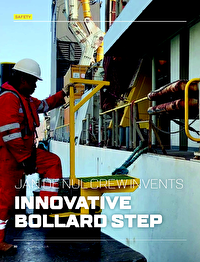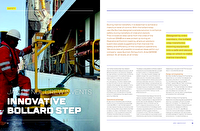Jan De Nul’s bollard step has created a solution that is both easy and quick to use, as well as being low on maintenance. Designed by crew members, the bollard step transforms mooring equipment into a safe and secure step on which to make marine transfers. The main materials used are steel and anti-skid grating. The latter creates a safe surface from which one can make a safe transfer either between two vessels or from a vessel to the shore. The fact that the bollard step is quick and easy to use is reflected in the way it is mounted: two persons can effortlessly carry the two parts of the step and put it in place without the need for extra securing measures.
Operational advantage
A major plus of the bollard step not being a fixed structure is the operational advantage it provides. When in use, the deck space is not restricted as the step can be dismounted at any time (e.g. when cargo needs to be lifted on deck), nor does it interfere with mooring operations. If mooring operations would be hindered, the bollard step can simply be removed or placed on an alternative bollard. The design is adjustable to different sizes of bollards and could be extended with a longer surface to step on or made adjustable in length, in the case the width between two vessels is larger than usual. A simple and clever solution, the bollard step creates a safe and steady platform where there could never be a safe step-over zone. Thanks to a straightforward design, local workshops can easily manufacture the bollard step to match the specifications of locally hired vessels. The costs of the prototype were considerably low at around EUR 850 making it a cost effective solution.
There are several step designs that can be used on a variety of vessels. The innovation will also increase safety of crew transfers on small Crew Transfer Vessels (CTVs) where designated means of transfer such as built-in steps are temporarily out of use. Future enhancements of the design could include an adjustable platform at the end to cope with different project locations. One benefit is that CTVs that otherwise might not be suitable during a project could therefore be used thanks to the bollard step. Depending on the cost of the CTV, this could result in considerable savings.
Design and engineering
Normally, the Marine Design and Engineering Department of Jan De Nul first designs the equipment, after which it is manufactured. ‘For the bollard step it was somewhat different’, explains Wouter Tollet, coordinator of the Marine Design and Engineering Department. ‘The crew members first created it for the use on their vessel. We then took over that design and improved it for fabrication so it can be used on all workboats and possibly other crafts as well.’
The Marine Design and Engineering department provides engineering assistance resulting in successful, efficient and safe execution of projects. ‘Our designers are responsible for the design of equipment and components for vessels and offshore structures in 2D and 3D’, says Wouter. ‘From the initial concept design to detailed drawings and related part lists, we provide a complete package for logistics, maintenance and production. In a second phase, our structural and marine engineers check the design against their calculations, ensuring safety and efficiency.’












